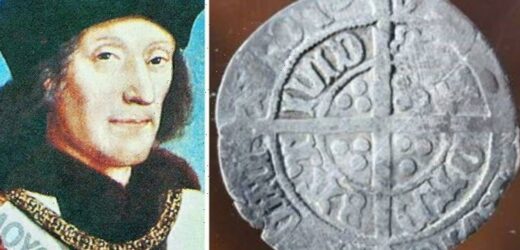Archaeologists discover drilled holes in mummified body in 2020
We use your sign-up to provide content in ways you’ve consented to and to improve our understanding of you. This may include adverts from us and 3rd parties based on our understanding. You can unsubscribe at any time. More info
The rare “half groat” was found during an excavation in Newfoundland at the site of a former English colony in Canada. It is thought to have been minted in Canterbury more than 520 years ago around the time between the years 1493 and 1499. The Government of Newfoundland said that the coin is probably “the oldest English coin to ever be found in Canada, and possibly all of North America”.
Henry VII, the first monarch of the House of Tudor, reigned England from August 1485 to April 1509.
The coin was discovered by a team at Cupids Cove Plantation Provincial Historic Site, an archaeological site at what is now the town of Cupids.
It is suspected that the coin was taken across the Atlantic at some point after the colony was established in 1610, before it got lost.
William Gilbert, head archaeologist at Cupids Cove Plantation Provincial Historic Site said: “Some artefacts are important for what they tell us about a site, while others are important because they spark the imagination.”


“This coin is definitely one of the latter” he added.
Mr Gilbert continued: “One can’t help but wonder at the journey it made, and how many hands it must have passed through from the time it was minted in Canterbury until it was lost in Cupids sometime early in the 17th century.
“This is a major find and I am proud of my team for all their hard work. We look forward to the next great discovery.”
Mr Gilbert first encountered the historical site in 1995, which was established by English merchant adventurer called John Guy in 1610.

While disputed by some, most historians argue that the town of Cupids was the first attempt by England to set up a permanent settlement in what would later become Canada, according to National Trust for Canada.
Steve Crocker, Government of Newfoundland Minister of Tourism, Culture, Arts and Recreation, said: “The historical significance of the Cupids Cove Plantation Provincial Historic Site has long been known and its value to the local tourism industry is proven.
This was during the reign of James I, the first Stuart king.
DON’T MISS
Alien life: Huge boost to Oumuamua ‘artificial origin’ theory [REVEAL]
Galileo blow as BT signs historic deal with UK alternative [REPORT]
‘She is the true leader’ Sturgeon upstages Boris at COP [INSIGHT]


Mr Guy, who was from Bristol in England, had visited Newfoundland in 1608 to try and choose a possible location for a colony, before being granted a charter to proceed with the colonisation of Newfoundland in 1610.
The Government of Newfoundland said research on the coin is still going on, but that it’s expected to be put on display at the Cupids Cove Plantation Provincial Historic Site at some time next year.
“It is incredible to imagine that this coin was minted in England and was lost in Cupids over 100 years later. It links the story of the early European exploration in the province and the start of English settlement.”
Source: Read Full Article


